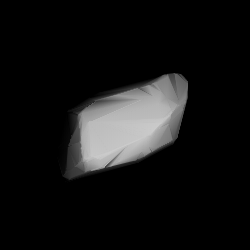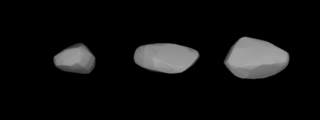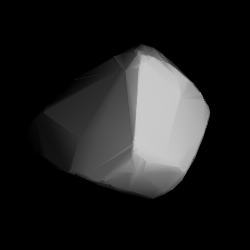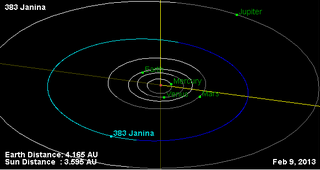
244 Sita is a background asteroid from the inner region of the asteroid belt, approximately 11 kilometers in diameter. It was discovered on 14 October 1884, by an Austrian astronomer Johann Palisa in the Vienna Observatory and was named for the Hindu deity Sita.

265 Anna is a typical Main belt asteroid.

267 Tirza is a fairly sizeable, very dark Main belt asteroid.

295 Theresia is a typical Main belt asteroid. It was discovered by Johann Palisa on 17 August 1890 in Vienna.

317 Roxane is an asteroid from the asteroid belt approximately 19 km in diameter. It was discovered by Auguste Charlois from Nice on September 11, 1891. The name was chosen by F. Bidschof, an assistant at the Vienna Observatory, at Charlois' request; Bidschof chose to name it after Roxana, the wife of Alexander the Great, and at first used the spelling "Roxana".

347 Pariana is a metallic background asteroid from the central region of the asteroid belt. It was discovered by French astronomer Auguste Charlois at the Nice Observatory on 28 November 1892. The M-type asteroid has a short rotation period of 4.1 hours and measures approximately 49 kilometers in diameter. The origin of the asteroid's name remains unknown.

378 Holmia is a typical Main belt asteroid.

383 Janina is a Themistian asteroid, approximately 46 kilometers in diameter. It is spectral B-type and is probably composed of primitive carbonaceous chondritic material.
501 Urhixidur is a relatively large main belt asteroid. It was discovered on 18 January 1903, by astronomer Max Wolf (1863–1932), at the Heidelberg Observatory in southwest Germany. Like 500 Selinur and 502 Sigune, it is named after a character in Friedrich Theodor Vischer's then-bestseller satirical novel Auch Einer.
476 Hedwig is a main-belt asteroid discovered on 17 August 1901 by Luigi Carnera at Heidelberg. Named in honour of the wife of Swedish-Danish astronomer Elis Strömgren.

499 Venusia is an asteroid in the outer asteroid belt, discovered by Max Wolf in 1902. Its diameter is 81 km. It is a dark P-type asteroid. It has an average distance from the Sun of 4 AU (600 million km).
500 Selinur is a minor planet, specifically an asteroid orbiting in the asteroid belt. Like 501 Urhixidur and 502 Sigune, it is named after a character in Friedrich Theodor Vischer's then-bestseller satirical novel Auch Einer.

502 Sigune is a minor planet, specifically an asteroid orbiting primarily in the asteroid belt. Like 501 Urhixidur and 500 Selinur, it is named after a character in Friedrich Theodor Vischer's then-bestseller satirical novel Auch Einer.
545 Messalina is a minor planet, specifically an asteroid orbiting primarily in the asteroid belt. It was discovered on 3 October 1904 by Paul Götz, at Heidelberg. It is named after Valeria Messalina, the third wife of Roman Emperor Claudius.
612 Veronika is a minor planet orbiting the Sun. It was discovered on 8 October 1906 by August Kopff from Heidelberg. The reason for the name is unknown; asteroid etymologist Lutz D. Schmadel suspects that it may have been inspired by the letter code "VN" in its provisional designation, 1906 VN.
622 Esther is a minor planet orbiting the Sun.
661 Cloelia is a minor planet orbiting the Sun that was discovered by American astronomer Joel Hastings Metcalf on February 22, 1908.
853 Nansenia is a minor planet orbiting the Sun. It is named after the Norwegian polar explorer and Nobel Peace Prize laureate Fridtjof Nansen.
902 Probitas is a minor planet orbiting the Sun. It was discovered by an Austrian astronomer Johann Palisa in Vienna on 3 September 1918.
3551 Verenia, provisional designation 1983 RD, is an Amor asteroid and a Mars crosser discovered on 12 September 1983 by R. Scott Dunbar. Although Verenia passed within 40 Gm of the Earth in the 20th century, it will never do so in the 21st. In 2028 it will come within 0.025 AU of Ceres.










